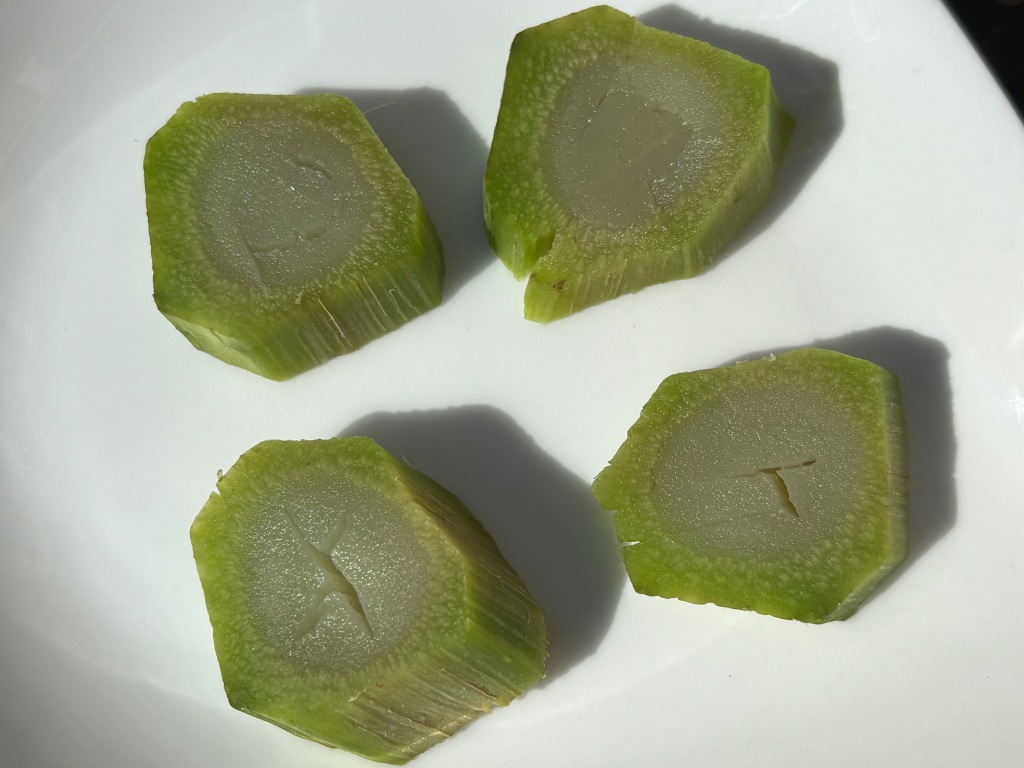
Friends recently told me that they love to start their day with a smoothie made with just an apple, an orange and a cooked beet. That sounded interesting! So I thought I’d experiment with that combination.
After blending these three ingredients plus a splash of kombucha, I got a gorgeous and delicious mixture that tasted fruity and also earthy like beets.

Then, I spooned some of this beet/fruit mixture into little cups and topped each serving with plain whole milk kefir (as shown in the photo below). The kefir seeped into the spaces between the beet/fruit mixture and created food art! And, with every spoonful of these little “sundaes,” I tasted two delightfully contrasting flavors — the creamy tart kefir and the sweet fruit/earthy beet flavor!

Next, I added a little more kefir and gave it a stir, and the “sundae” turned into a delicious smoothie, as shown below.

So, as you can see, with just a few healthful ingredients, you can create a refreshing drink and also a work-of-art “sundae!”
About the nutrition of each ingredient
Kefir and kombucha –
“Entry level” fermented foods to try today!
Kefir and kombucha are fermented foods and as such they provide us with probiotic bacteria. Our ancestors didn’t have refrigeration, so they fermented many foods. Modern day diets are woefully lacking in fermented foods (and fiber) and our guts are woefully lacking in bacterial diversity… We need to add fermented foods (and fiber) back to rehabilitate our microbiomes and improve our health. (See this article re Signs your probiotics are working for you.)
If you haven’t tried kefir, go for it! It’s kind of like buttermilk or drinkable yogurt. And kombucha is like a fruity sparkling juice that’s a bit on the sour side. Both are great staples to keep in your refrigerator so you can invent your own delightful concoctions anytime!
Oranges –
Don’t throw out the good stuff!
When you think about eating an orange, you probably only think about eating the orange sections, not the peel (the thin deep orange colored layer on the outside) and not the pith (the white spongy substance between the peel and the juicy orange). But both the peel and the pith are nutrient rich as you will see from this paper about orange peel and this paper about orange pith. But, don’t dump the whole orange into your blender! That would make the mix too bitter!
Oranges: Food Prep Tips to add nutrition
Peel: Before you cut your orange, use a really sharp vegetable peeler to remove some of the orange’s peel, then chop the peel into small pieces and add these to your blender.
Pith: Be sure to leave most of the pith attached to the orange segments. The pith is slightly bitter, but not as bitter as the peel. In photo at top of this page, you can see that I left some of the white pith on the cut orange. I could have left more than I did and next time, I’ll do that.
Organic: If you plan to use the peel and the pith, be sure your orange is organic.
Apples –
An apple a day. There’s truth to that!
For info on the nutrition and health benefits of apples, click here.
Beets –
Beets for better brains and better athletic performance!
For information about the nutrition of beets and their many different health benefits, see this summary. Also, you might want to “geek-out” on this article about the brain- and athletic-boosting benefits of the nitrites in beets.
Cooking beets
I like to steam fresh beets in the microwave. It’s so easy! Just cut off the tops (reserve the leafy tops and the stems to make sautéed beet greens), scrub the beets clean and then put the beets, whole or cut in half if they are big, into a microwaveable bowl, add a little water, and cover with a lid (which can be a plate). Check for doneness after about 5 minutes. When the beets are cooked to your liking (and for this recipe they do not need to be fully cooked), don a pair of kitchen gloves and grabe a sharp vegetable peeler to peel off the skins. Or just leave the skins on and blend the beets with their skins! (I peeled the skins, but next time, I will keep the skins on, for more fiber and more nutrients!)
What are you going to do with the beet greens? Eat them!
These days I microwave beet greens, and the information on that is in this updated post about beet greens.
SIGN UP NOW: As mentioned in a recent post, if you are interested to learn more about food and your microbiome, you can attend a Zoom program, free, with Will Bulsiewicz on May 8. Sign up now! See you there!
Enjoy and be healthy!
Leni






